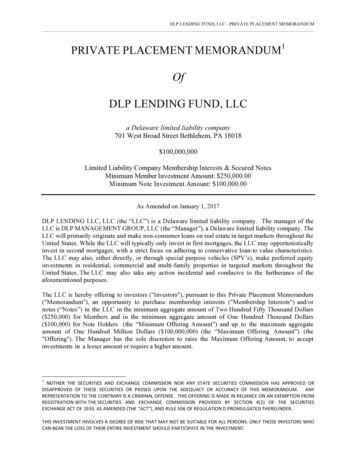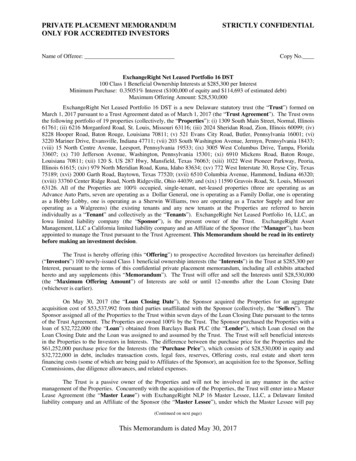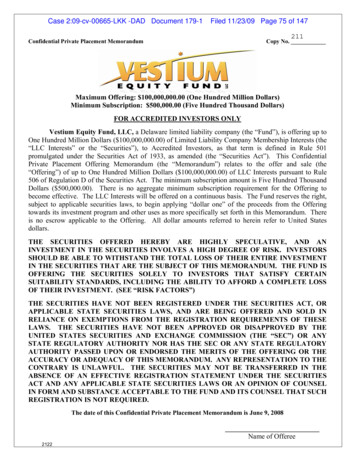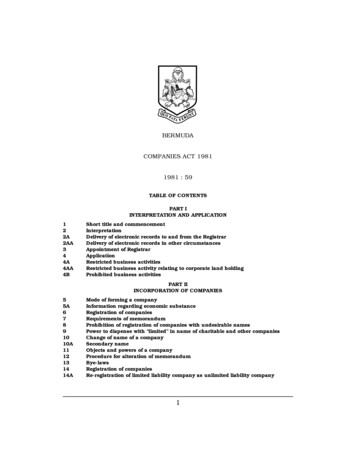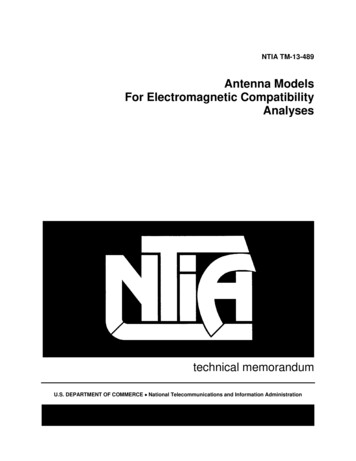
Transcription
MEMORANDUMTO:Steve Alpert, President, American Academy of Actuaries(Sent via e-mail to Mary Downs, Executive Director, downs@actuary.org)Brian Z. Brown, President, Casualty Actuarial Society(Sent via e-mail to Cynthia R. Ziegler, Executive Director, cziegler@casact.org)Mike Lombardi, President, Society of Actuaries(Sent via e-mail to Greg Heidrich, Executive Director, gheidrich@soa.org)FROM:Kris DeFrain, Director of Research and Actuarial ServicesDATE:April 4, 2018RE:NAIC Standards and Assessment ProjectThank you for meeting with the NAIC at the Spring National Meeting in Milwaukee. The ad hoc group ofcommissioners overseeing the project has agreed to limit the use of the knowledge statements to developingminimum educational standards and assessing actuarial educational programs. The group has agreed that theapplication of the knowledge statements to define qualifications of an individual actuary is not appropriate.Attached is a revised working definition of a qualified actuary (Appendix 1) and revised Statement of ActuarialOpinion instructions (Appendix 2). The plan of action remains the same as what was outlined in my March 16letter. We will begin the project “Development of P/C Appointed Actuary Educational Standards and Assessmentof Professional Actuarial Organizations’ Examinations and Educational Content for Designations” (the“Standards and Assessment Project”) upon agreement of the plan of action.The Knowledge Statements derived from the Appointed Actuary job analysis, which provide the “breadth” ofknowledge, will be used to develop Educational Standards, which will provide the “depth” of knowledge(Appendix 3). Any item not included in an educational standard but included in a knowledge statement, will beassumed to be an issue that an individual actuary may need to learn via experience or continuing education inorder to be an Appointed Actuary.The educational standards will be used to assess the syllabi and examination content of the P/C actuarialeducational programs.I would like to set up a call this week to discuss the plan and associated timelines in Appendix 4.Should you have any immediate questions, please contact me at kdefrain@naic.org or 816-783-8229.CC: Ad Hoc Commissioner Group of the Executive (EX) CommitteeK:\\Letter to Actuarial Organizations 040418.docx
Appendix 1Statement of Actuarial Opinion InstructionsDefinition of a Qualified ActuaryThe following definition of “Qualified Actuary” is the current proposed “working definition” (not adopted) to beincluded in Section 1A. Definitions of the Actuarial Opinion instructions for Statements of Actuarial Opinion:1A. Definitions “Qualified Actuary” is a person who:(i)meets the basic education, experience and continuing education requirements of the SpecificQualification Standard for Statements of Actuarial Opinion, NAIC Property and Casualty AnnualStatement, as set forth in the Qualification Standards for Actuaries Issuing Statements of ActuarialOpinion in the United States (U.S. Qualification Standards), promulgated by the American Academyof Actuaries (Academy); and(ii)has obtained an actuarial designation approved by the NAIC as meeting or exceeding the NAIC’sminimum property/casualty actuarial educational standards; and(iii)has sufficient experience and knowledge to understand reserving for the company’s lines of businessand business activities; and(iv)is a member of a professional actuarial association subject to the same Code of Conduct promulgatedby the Academy, the U.S. Qualification Standards, and the Actuarial Board for Counseling andDiscipline when practicing in the U.S.An exception to this definition would be a person evaluated by the Academy’s Casualty Practice Council anddetermined to be a Qualified Actuary for particular lines of business and business activities. Should a personqualify under this alternate route, the actuary must attach a copy of the approval letter from the Academy to theActuarial Opinion each year.Note: This definition contemplates the Academy will revise the U.S. Qualification Standards in line with theNAIC instructions.2
Appendix 2Proposed Changes to theStatement of Actuarial Opinion InstructionsThe following is a draft of potential changes to the Actuarial Opinion instructions for Statements of ActuarialOpinion, including the revised working definition of “Qualified Actuary.” A placeholder is added for insertion ofrequirements for an Attestation requirement to be decided by the Casualty Actuarial and Statistical (C) TaskForce, which will be consistent with the revised working definition of a qualified actuary.This proposal will continue to be modified with expectation of adoption for Statements of Actuarial Opinion filedon 2019 annual financial statements.ACTUARIAL OPINION 1A. Definitions “Qualified Actuary” is a person who:(i)meets the basic education, experience and continuing education requirements of the SpecificQualification Standard for Statements of Actuarial Opinion, NAIC Property and Casualty AnnualStatement, as set forth in the Qualification Standards for Actuaries Issuing Statements of ActuarialOpinion in the United States (U.S. Qualification Standards), promulgated by the American Academyof Actuaries (Academy); and(ii)has obtained an actuarial designation approved by the NAIC as meeting or exceeding the NAIC’sminimum property/casualty actuarial educational standards; and(iii)has sufficient experience and knowledge to understand reserving for the company’s lines of businessand business activities; and(iv)is a member of a professional actuarial association subject to the same Code of Conduct promulgatedby the Academy, the U.S. Qualification Standards, and the Actuarial Board for Counseling andDiscipline when practicing in the U.S.An exception to this definition would be a person evaluated by the Academy’s Casualty Practice Council anddetermined to be a Qualified Actuary for particular lines of business and business activities. Should a personqualify under this alternate route, the actuary must attach a copy of the approval letter from the Academy to theActuarial Opinion each year. 3. Identification ParagraphThe IDENTIFICATION paragraph should indicate the Appointed Actuary’s relationship to the Company,qualifications for acting as Appointed Actuary and date of appointment, and specify that the appointment wasmade by the Board of Directors.These Instructions require that a Qualified Actuary prepare the Actuarial Opinion. Nevertheless, if a person whodoes not meet the definition of a Qualified Actuary has been approved by the insurance regulatory official of thedomiciliary state, the Company must attach, each year, a letter from that official stating that the individual meetsthe state’s requirements for rendering the Actuarial Opinion.10.Exhibit B: DISCLOSURES .3. The Appointed Actuary has the following designation (indicated by the letter code):F if a Fellow of the Casualty Actuarial Society (FCAS)A if an Associate of the Casualty Actuarial Society (ACAS)G if a Fellow of the Society of Actuaries (FSA) and completed the General Insurance Track3
M if approved by the Academy’s Casualty Practice Council.O for Other .11. Attestation and Supporting Documentation------Attestation requirements are currently being redrafted by the Casualty Actuarial and Statistical (C) TaskForce.4
Appendix 3NAIC Educational StandardsAppointed Actuary “Knowledge Statements”Insurance regulators rely on expert actuarial opinions provided by Appointed Actuaries. Given the actuarialprofession is self-regulated in the U.S., the state insurance regulators believe it important to establish minimumexpectations of basic education for actuaries who are being relied upon by regulators.The following are the Knowledge Statements grouped by educational domain. For each Knowledge Statement,the Educational Standard will be developed to explain the depth of knowledge needed to be included in basiceducation and any additional knowledge that is expected to be learned outside of basic education throughexperience and/or continuing education.The overall assessment of whether professional actuarial designations are sufficient support for achievement ofthe Educational Standards will be reflected in the definition of a qualified actuary.A. LawThe Appointed Actuary must be able to assess the effect of the legal environment on the reserves for which theAppointed Actuary is opining, along with the associated risks and uncertainties. The Appointed Actuary mustunderstand relevant U.S. and state insurance law, regulatory authority, and regulations. The Appointed Actuarymust be aware of tort law, relevant types of litigation, including class actions and mass torts, as well as precedentcase law and changes therein.Knowledge Statements:1. Key elements of tort law, tort trends and reforms2. Insurance law with respect to its impact on P/C insurance3. Mass torts/class action suits and their impact on the P/C insurance industry4. Legal environment (e.g., coverages and claims subject to the Statement of Actuarial Opinion) andchanges therein5. Financial solvency regulation’s purpose6. U.S. federal and state laws and regulations that pertain to the Statement of Actuarial Opinion7. State specific laws, regulations, regulatory authority and rules regarding the preparation of annualstatements8. Precedent case law on issues affecting P/C reserves (e.g., bad faith, punitive damages awards, classcertification)B. Policy Forms and Coverages, Underwriting, and MarketingThe Appointed Actuary must be able to assess the effect of insurance coverages, underwriting and marketing, andchanges therein on the reserves for which the Appointed Actuary is opining, along with the associated risks anduncertainties. The Appointed Actuary must understand types of insurable exposures, related insurance products,and how insurance companies assume risk through marketing and underwriting.Knowledge Statements:1. Policy forms including exposures, limits, coverage triggers, policy terms and conditions, endorsementsand exclusions, attachment points, and reinsurance reinstatement provisions2. Claims experience impact from deductibles, limits, treatment of loss adjustment expenses and exclusionsto coverage3. Primary insurance, excess insurance, ceded reinsurance and assumed reinsurance4. Company liabilities that arise from participation in government/industry programs and their interactionwith voluntary private insurance sector5. Exposures across different lines of business (e.g., possible differences)5
6. The impact of changes in underwriting, mix of business, or target market on claims' experience (e.g.,classifications, underwriting variables, guidelines, growth, profitability, staffing, programs, appetite, ratechanges)7. Rating plans (e.g., individual risk rating, class rating, experience rating, retrospective rating, participatingpolicies, judgment rating, schedule rating), and the impact of changes therein.8. Risks specific to the business (e.g., mass tort potential, latent exposures, new coverages, emerging risk,bad faith, extra contractual obligations, long duration contracts, potential for salvage and subrogation)9. Claims experience changes when considering organizational, operational and marketing differences (e.g.,stock, mutual, direct, agency, captives, risk retention groups, voluntary and involuntary pools, use of thirdparty administrators, target markets, distribution channels, sales incentives, competitors)C. ReinsuranceThe Appointed Actuary must be able to assess the effect of reinsurance on the reserves for which the AppointedActuary is opining, along with the associated risks and uncertainties. The Appointed Actuary must understand thefunctions and types of reinsurance, relevant contract features, risk transfer principles, and reinsurance accounting,recognition and collectability issues.Knowledge Statements:1. Basic reinsurance terminology (e.g., limits, retentions/attachment points, quota share, excess of loss,clauses, reinstatements, co-insurance, commissions)2. The function and types of reinsurance3. Reinsurance contracts interpretation4. Reinsurance contracts to determine the treatment of loss adjustment expenses (LAE) (e.g., within limits,in addition to limits, shared pro rata)5. Commutations and novations including definition, motivations of parties, accounting treatment6. Impact on financial statements from contract qualification criteria for prospective or retroactivereinsurance accounting treatment or deposit accounting treatment7. Reinsurance risk transfer testing8. Assessing collectability (e.g., sources, rating agencies, letters of credit, news items, amounts in dispute oroverdue)9. The impact of authorized, unauthorized, certified reinsurance on collateral and collectability10. Differences between reinsurance and primary reserving procedures (e.g., adapting methods for availabledata, type of reinsurance, terms)11. Factors considered in the evaluation of the applicability of a reinsurance program to an unpaid claimestimate12. Possible parameter differences for direct, assumed, gross, ceded and net data (e.g., loss developmentfactors and initial expected loss ratios)D. Premium, Loss, and Expense ReservesThe Appointed Actuary must be able to derive estimates that recognize the internal and external environment,along with the associated risks and uncertainties. The Appointed Actuary must understand and apply reservingmethods, analysis, and diagnostics to derive actuarial reserve estimates. The Appointed Actuary must understandthe company’s internal operations and data, external environment, and relevant changes therein.Knowledge Statements:1. Possible effects of external conditions on the analysis (e.g., legal, recent court decisions, economic,judicial, regulatory, market) and changes therein2. The company’s internal operations (e.g., underwriting, claims, marketing, IT, finance, investment,reporting, product offerings, assumed and ceded reinsurance programs) and changes therein3. P/C claims' operations and changes therein6
4. Key activities in the claims handling process (e.g., claims' investigations, claims' documentation, cause ofloss determination, liability, loss amount, claim conclusion, procedures, staffing or outsourcing, controlson timing and amounts of case investigations, case reserves and payments, diary dates, claims auditinvolvement, information flows from claims to accounting/actuarial sources)5. Processes used by the company for handling and managing claims in various lines and classes of business6. The effects of changes in claims handling on the reserve analysis7. IT environment (e.g., exposure, premium and loss reporting, claim count data, claim closing, report dates,year-end closing date, claim processing speeds, system implementations) and changes therein8. Data compiling methods to conduct data analysis (e.g., accident year, report year, policy year, limited,unlimited, truncated, loss adjustment expenses' treatment, salvage and subrogation, direct, assumed,ceded, net, gross, coverage)9. Key terms including case outstanding, paid claims, reported claims, IBNR, ultimate claims, claims relatedexpenses, reported and closed claim counts, claim counts closed with no payment, insurance recoverables,exposures, experience period, maturity or age, and components of unpaid claim estimates10. Role of homogeneity and credibility of data in the process of compiling and segmenting data andestimating unpaid claims11. Accounting date, valuation date, and review date differences12. Data reconciliations13. IT and Accounting procedures and processes14. Data management and quality (e.g., request, compile, and clean data; check data for reasonableness andconsistency)15. Diagnostics (e.g., triangles and ratios of average case reserves, paid severities, incurred severities, closedto-reported claim counts)16. Researching data issues17. Appropriateness of using industry data and potential differences between industry experience andcompany experience (e.g., differences in policy forms and coverages, underwriting and marketing)18. Composition and applicability of industry benchmarks for reserve analysis19. Actuarial analysis methods to determine actuarial estimates for all items within the scope of the opinion(e.g., premium reserves, unpaid claims, claim counts, recoveries) including carrying out the mechanics,selecting the assumptions, identifying the strengths and weaknesses of those methods (e.g., , ChainLadder, Expected claim, Bornhuetter-Ferguson, Cape Cod, Frequency-Severity methods, methods tocalculate Defense and Cost Containment Loss Adjustment Expenses (DCC) and Adjusting and OtherLoss Adjustment Expenses (AO), and legal entity allocation)20. Computation methods for other premium reserves required in the opinion (e.g., death, disability andretirement, extended reporting endorsements, long duration contracts)21. Reserving methods for unearned premiums and IBNR for policies with non pro-rata earning patterns22. Diagnostic usage to select methods and parameters23. Treatment of recoveries such as reinsurance, policyholder deductibles, and salvage and subrogation24. Three tests required by Statement of Statutory Accounting Principles (SSAP) 65--Property and CasualtyContracts to test unearned premium reserves on long duration contracts25. Loss development, trend, and the differences between them26. Estimating unpaid claims by layer methods27. Methodologies and considerations for unique lines of business or claim types (e.g., asbestos, surplus lines,construction defect claims, health coverages written on P/C annual statement)28. Fundamentals of different types of insurance (e.g., long tail versus short tail lines of business, lowfrequency versus high frequency lines)29. Data adjustments and estimation techniques for material changes (e.g., large losses, catastrophes, patternselection, retentions, limits, claims' processes, case reserve adequacy, closing and payout rates, economicand legal environment, mix of business, coverages, trend, rapid growth or decline)30. Test assumptions and results for reasonableness (e.g., ultimate frequencies and severities, ultimate purepremiums, ultimate loss ratios, actual vs. expected, diagnostics, prior year results)31. Approaches to select actuarial central estimates and/or ranges of reasonable estimates (e.g., stochastic,deterministic)7
32. Intended measures of the reserve estimate (e.g., actuarial central estimate, management's best estimate,high and low estimates, range of reasonable estimates)33. Risk and uncertainty associated with a reserve analysis including approaches to quantify risk34. Approaches and considerations in discounting reserves (e.g., interest rates, risk margins)35. Relevant principles regarding property and casualty unpaid claims estimates36. Premium asset for retrospectively rated policies37. Premium deficiency reserves38. Earning premiums39. Premium earning patterns based on expected claim occurrence timelines40. Principles and techniques of ratemaking as may be applicable for estimation of unpaid claims (e.g., ratechanges, on-level loss ratios, trend, benefit, mix of business)41. The effect of rate changes by year on loss ratios if using loss ratios as a guide to select the ultimate loss42. Trend analyses (e.g., exposure trend, frequency trend, severity trend, pure premium trend, premium trend)43. Analysis adjustments (e.g., effect of law changes, effect of changes in mix of business, adjustment forcoverage and benefit level changes, large loss adjustment)44. Use of relevant available work products of the previous Appointed ActuaryE. Statutory Insurance Accounting and Role of The Appointed ActuaryThe Appointed Actuary must be able to produce a Statement of Actuarial Opinion, an Actuarial Opinionsummary, and an Actuarial Report in accordance with the NAIC Annual Statement Instructions. The AppointedActuary must understand relevant statutory accounting principles and reporting requirements for the U.S. NAICP/C Annual Statement. The Appointed Actuary must understand the responsibilities of an Appointed Actuary,including key deliverables.Knowledge Statements:1. Opinion reporting requirements for the actuary; type of opinion to render (“Reasonable Provision,”“Deficient or Inadequate Provision,” “Redundant or Excessive Provision,” “Qualified Opinion” or “NoOpinion”)2. Basic terms used in statutory insurance accounting (e.g., paid loss, incurred loss, incurred but notreported--IBNR, defense and cost containment expenses, adjusting and other expenses)3. Derivation of statutory surplus and income4. Annual statement pages for evaluating reserves and overall financial health of the company (e.g., incomestatement, five-year historical data, Schedule P, Schedule P interrogatories, Schedule F, balance sheet,Notes to Financial Statements, general interrogatories, Underwriting and Investment Exhibit)5. NAIC Risk-Based Capital (RBC) and relevant state laws6. Financial health evaluation methods (e.g., NAIC IRIS, financial rating, risk-focused examinations/analysis, NAIC RBC)7. Relevant Statements of Statutory Accounting Principles (SSAPs) and permitted practices8. The role of the Appointed Actuary9. Instructions, purposes and users for the Statement of Actuarial Opinion and Actuarial Opinion Summaryin the NAIC annual statement instructions10. Exposures included in the P/C statutory annual statement that are outside of the Appointed Actuary's areaof expertise and whether/how to make use of appropriate expertise11. Schedule P reconciliation vs audit of the analysis data12. Materiality standard selection (e.g., intended purpose and the intended users of the Statement of ActuarialOpinion, Risk-based Capital (RBC) calculations and the impact on a materiality standard)13. Company's legal structure including pooling and reinsurance agreements14. Changes in Company activities related to policy forms and coverages, underwriting and marketing15. IRIS Property/Casualty Ratios16. Reasons for unusual value(s) for IRIS Property/Casualty Ratio 11 - One-Year Reserve Development toPolicyholders’ Surplus, Ratio 12 - Two-Year Reserve Development to Policyholders' Surplus, or Ratio 13- Estimated Current Reserve Deficiency to Policyholders’ Surplus and reasons for adverse developmentexceeding 5% of surplus in at least three of the last five years8
17. Meaning of "significant" and "material" considering users' needs for the purposes of determining Risk ofMaterial Adverse Deviation (RMAD)18. Understand the causes and drivers of loss and LAE development19. State law and/or state filing requirements for the Actuarial Opinion Summary (to determine if required)20. Data elements that are significant to the analysis in compliance with the NAIC Annual StatementInstructions for annual audited financial reports21. How to effectively communicate with and to an auditor audience22. Processes after discovery of a material error23. Processes related to the change in Appointed Actuary24. Reconcile net and gross values in the Actuarial Opinion Summary to the Actuarial Report and theStatement of Actuarial Opinion25. Practices described in the American Academy of Actuaries Committee on Property and LiabilityFinancial Reporting's (COPLFR) Practice Note Statements of Actuarial Opinion on Property andCasualty Loss Reserves26. Other items that might be within the scope of the opinion (e.g., unearned premium reserve on longduration contracts, Death, Disability and Retirement (DD&R) reserves, retroactive reinsurance liabilitiesand deposit contract liabilities)27. The effect of reinsurance including retroactive and financial; potential reinsurance collectability issues28. Narrative and technical components of an Actuarial Report consistent with relevant actuarial standardsand regulatory requirements, including a comparison of current estimates to comparable prior estimates,and reference to use of another Actuary’s workF. Professionalism and Business Skills30%The Appointed Actuary must have professional and business skills to enable the Appointed Actuary to performthe required actuarial services in an ethical manner that upholds the reputation of the actuarial profession.2TheAppointed Actuary must know and adhere to the Code of Professional Conduct as well as relevant ActuarialStandards of Practice and must meet the U.S. Qualification Standards. The Appointed Actuary must have theprofessional and business skills to manage the tasks, make informed decisions, communicate effectively withusers of the actuary’s work products, resolve disagreements, and seek guidance as necessary.Knowledge Statements:1. Relevant Actuarial Standards Board's Actuarial Standards of Practice (ASOPs), Qualification Standardsfor Actuaries Issuing Statement of Actuarial Opinion in the United States (U.S. Qualification Standards),Code of Professional Conduct2. Decision Making and Communication skills (e.g., oral, written, listening), professional and businessskills, and dispute resolution skills to resolve any issues related to the assignment as raised by companymanagement, the company's Board of Directors, regulatory authorities, the actuarial profession, auditors,and/or the actuary's employer9
Appendix 4Educational Standards and Assessment ProjectPotential Action PlanThe following is a potential action plan for development of Educational Standards, for assessment of the CAS andSOA P/C actuarial educational programs, and for final adoption of revisions to the Statement of Actuarial OpinionInstructions. The NAIC would like to discuss the plan with the actuarial organizations and agree to workabletimelines.ParticipantsThe NAIC ad hoc group of Commissioners will continue to oversee the development of Educational Standardsand the Assessment and will determine the final proposal to the Executive (EX) Committee for adoption.The NAIC will establish groups of actuaries with the following stated minimum responsibilities:1) The actuarial associations will nominate Subject Matter Experts (SMEs) and the NAIC will select SMEsand regulators to participate in the process.2) The NAIC will establish SME Subgroups - a group of 25 to 30 SMEs will be paired-up and each pairassigned a set of 5-10 related Knowledge Statements. The SME Subgroups will meet via conference call.3) The NAIC will establish a Focus Group – a group of 5 members. The Focus Group will oversee all of theSME Subgroups and be the decision makers on what to present to the NAIC, when needed. The FocusGroup will conduct some work via conference call and hold up to 5 meetings in person.4) As the current U.S. educational societies, the CAS and SOA will be asked to participate in multiple steps.Educational Standards and AssessmentThe following is the action plan for development of Educational Standards and the Assessment:A. Evaluate Knowledge Statements and propose any revised wording.B. Propose draft Educational Standards.C. Evaluate the proposed draft Educational Standards and create the final Educational Standards to use in theAssessment process.D. Map the CAS and SOA educational content (reading materials, etc.) to each Knowledge Statement andEducational StandardE. Assess the CAS and SOA educational content for each Educational Standard.F. Produce an over-all assessment of whether the CAS and SOA educational content meets the NAIC’sminimum standards.The following provides details of the action plan for development of Educational Standards and the Assessmentand includes potential deadlines for each step:A. Evaluate Knowledge Statements and propose any revised wording.1) Who:i) The SME Subgroups will evaluate the Knowledge Statements to propose any revised wording,considering any suggested changes made via Feb. 12 comment letters. [April 30]ii) The NAIC will decide the final Knowledge Statements. [May 15]2) Why: This is being done because the drafting process in the job analysis project did not include timeto wordsmith the Knowledge Statements.B. Propose Educational Standards.1) Who:1) The SME Subgroups will propose standards to the Focus Group. [June 1]2) The Focus Group will propose standards to the NAIC. [June 15]10
2) Principles: The Educational Standards should be developed using the following principles:i) The standards should be minimum standards for a 2019 P/C Appointed Actuary. The CAS and SOA will educate a wider group of actuaries for multiple tasks beyond thatneeded for a P/C Appointed Actuary.ii) The standards are for a point in time for what an actuary needs to know NOW. The CAS and SOA will have their own Educational Standards that will be more futuristic;again, for our purposes, these are minimum standards.iii) The standards should be such that typical lines of business and business activities are includedin education. The proposal will include documentation of any portion of Knowledge Statements wherethe view is that a large portion (e.g. 90%) of practicing Appointed Actuaries will not needthe knowledge and thus, the education does not need to be in the minimum EducationalStandards but could be learned by experience and/or continuing education when needed.iv) The standards should follow the 103 current Knowledge Statements closely, if not be a one toone match.v) Document any remaining Knowledge Statements or portions of Knowledge Statements thatmust be met by experience and/or continuing education.vi) Document any remaining Knowledge Statements where the view is that a large portion (e.g.90%) of practicing Appointed Actuaries will not need the knowledge and thus, do not need tobe in the Educational Standards but could be learned by experience and/or continuing educationwhen needed.C. Evaluate the proposed Educational Standards and create the Educational Standards for use in theAssessment process.1) Who: The NAIC will complete this step. [July 1]D. Map the CAS and SOA educational content (reading materials, etc.) to each Knowledge Statement andEducational Standard.1) Who: The CAS and SOA will conduct their
experience and/or continuing education. The overall assessment of whether professional actuarial designations are sufficient support for achievement of the Educational Standards will be reflected in the definition of a qualified actuary. A. Law The Appointed Actuary must be able to assess the effect of the legal environment on the reserves for .

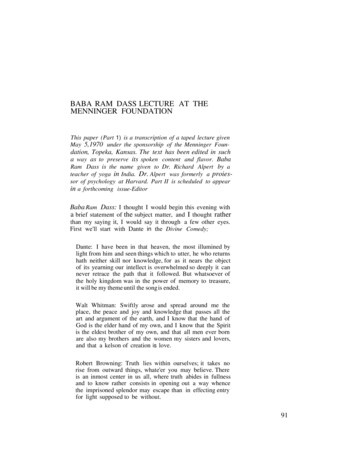
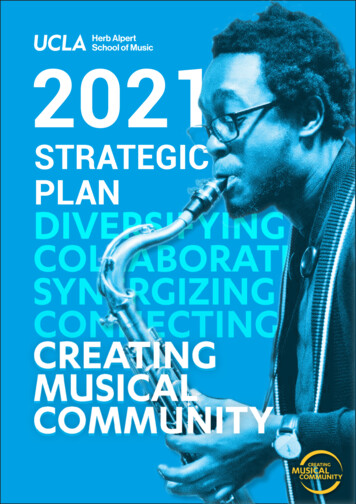
![WELCOME [ montclair.edu]](/img/31/commencement-program-2022.jpg)

